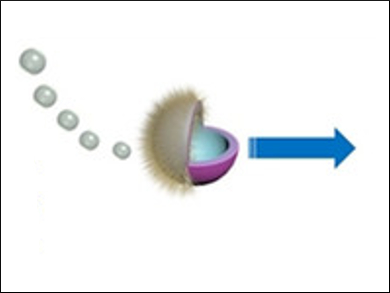Micro-/nanomotors (MNMs) are tiny machines which can convert energy into mechanical motion. They can perform complex operations such as capture, transport, release, and separation. To use these properties, it is important to accurately control the motion of MNMs. However, it remains a challenge to construct an MNM with continuously variable speeds—like equipping an automobile with a gearbox with continuously variable transmission.
Qiang He, Xiankun Lin, and colleagues, Harbin Institute of Technology, China, have developed a method to regulate the motor speeds of MNMs by integrating a salt-responsive polymer brush. The team prepared a bubble-propelled hollow Janus microcapsule motor and then grafted a poly[2-(methacryloyloxy)ethyltrimethylammonium chloride] (PMETAC, pictured in yellow) brush on the Pt side of the motor (pictured in grey).
The microcapsules were prepared using SiO2 microparticles as templates, which were coated with poly(styrenesulfonate) sodium (PSS)/poly(allylamine hydrochloride) (PAH) bilayers (pictured in blue/purple) and then covered with layers of Cr and Pt on one half. The SiO2 core was removed using HF and the Pt part coated with the PMETAC brush.
The MNM swims in fluids propelled by bubbles, which are created by the catalytic decomposition of H2O2 on the Pt side. The motor speeds can be tuned accurately by changing the type and concentration of the counterions of the PMETAC brush. This is caused by a change in the wetting properties of the PMETAC brush and its influence on the bubble propulsion. According to the researchers, this autonomous response to the local chemical environment could be a path to control the motion of smart MNMs that can act like swimming living systems.
- Continuously Variable Regulation of the Speed of Bubble-Propelled Janus Microcapsule Motors Based on Salt-Responsive Polyelectrolyte Brushes,
Yuxing Ji, Xiankun Lin, Daolin wang, Chang Zhou, Yingjie Wu, Qiang He,
Chem. Asian J. 2018.
https://doi.org/10.1002/asia.201801716



![Synthesis of [c2]Daisy Chains via Mechanochemistry](https://www.chemistryviews.org/wp-content/uploads/2025/04/202504_RotaxanesWithSolidStateMechanochemistry-125x94.png)
